Per impostazione predefinita, WordPress visualizza i post del blog nella home page. Tuttavia, se state creando un sito web aziendale o semplicemente volete personalizzare la vostra homepage, potreste volere una pagina separata per la sezione blog.
Questa configurazione non solo aiuta a mantenere la homepage pulita e focalizzata, ma fornisce anche uno spazio dedicato ai lettori per esplorare i contenuti del blog.
Per migliorare l’esperienza dell’utente e mantenere un focus chiaro sulle nostre offerte, abbiamo aggiunto pagine blog separate su molti siti web delle nostre aziende partner, tra cui WPForms, OptinMonster e All in One SEO. Questo permette ai visitatori di accedere facilmente ai contenuti del blog, dando al contempo la priorità all’obiettivo primario di promuovere i nostri plugin.
In questo articolo vi mostreremo due modi per creare una pagina separata per i post del blog in WordPress.
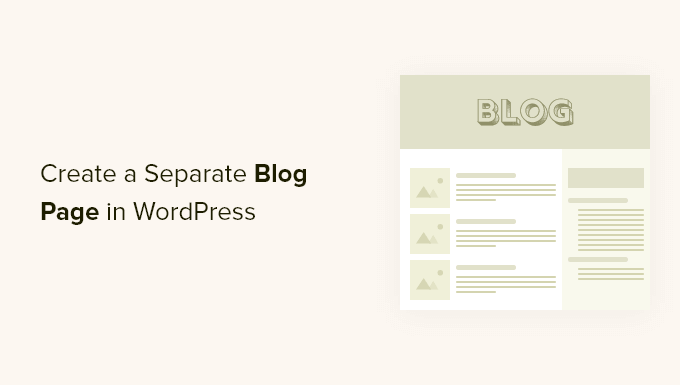
Perché visualizzare i post del blog in una pagina separata?
La home page è la pagina principale del vostro sito web WordPress e la prima pagina che i visitatori vedono. Per impostazione predefinita, WordPress mostra i post più recenti sulla home page, e questo ha senso se gestite un blog.
Ma non è sempre l’ideale per i siti web delle piccole imprese. Probabilmente vorrete una home page più accattivante, che illustri agli utenti la vostra attività, i vostri prodotti e servizi, consenta loro di sapere come contattarvi e aumenti la conversione delle vendite.
Ora, se volete gestire anche un blog sul vostro sito web, dovrete fornire un’altra pagina in cui i visitatori possano leggere i vostri post.
Detto questo, vi mostreremo come creare facilmente una pagina separata per i post del blog in WordPress.
In questa esercitazione abbiamo discusso due metodi e potete usare i link sottostanti per passare al metodo che preferite. Tenete presente che il secondo metodo è il più semplice e offre la massima personalizzazione:
Video tutorial
Se preferite le istruzioni scritte, continuate a leggere.
Metodo 1: Creare pagine separate per i post del blog in WordPress
È possibile creare una pagina separata per i post dei blog utilizzando le impostazioni predefinite di WordPress.
Tuttavia, questo metodo richiede un po’ più di lavoro rispetto al metodo 2 e non offre altrettante opzioni di personalizzazione.
Creazione di una pagina iniziale e di una pagina del blog separate
Per prima cosa, è necessario creare due pagine WordPress separate da utilizzare come homepage e pagina del blog.
Non è necessario aggiungere alcun contenuto a queste pagine e si può dare loro il nome che si preferisce. Ad esempio, alcuni siti web aziendali utilizzano “News” per la loro pagina blog.
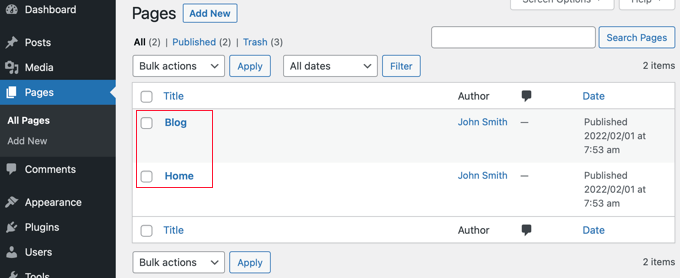
Una volta create queste pagine, visitate la pagina Impostazioni ” Lettura nell’area di amministrazione di WordPress.
A questo punto, nella sezione “Visualizza la tua homepage”, è necessario fare clic sul pulsante “Una pagina statica”.
Successivamente, è possibile selezionare le pagine Home e Blog create in precedenza. Scorrere verso il basso e fare clic sul pulsante “Salva modifiche”.

Ora, quando si accede alla schermata Pagine ” Tutte le pagine dalla dashboard di WordPress, si vedrà che la pagina Home è etichettata come ‘Prima pagina’ e la pagina Blog come ‘Pagina dei post’.
Fare clic sul link “Visualizza” sotto la pagina del blog per visualizzare l’anteprima.
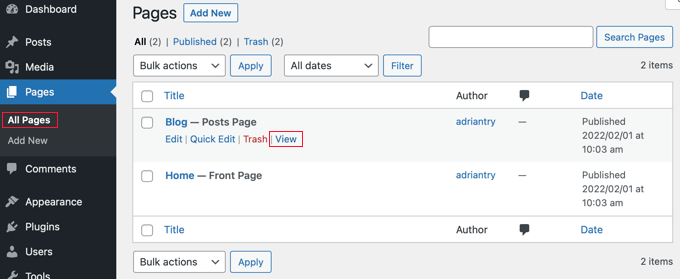
L’aspetto di queste pagine dipende dal tema di WordPress e si consiglia di configurare queste impostazioni.
Ad esempio, se il vostro tema ha un menu di navigazione, noterete che WordPress ha aggiunto automaticamente le nuove pagine Blog e Home. In caso contrario, consultate la nostra guida per principianti su come aggiungere un menu di navigazione in WordPress.
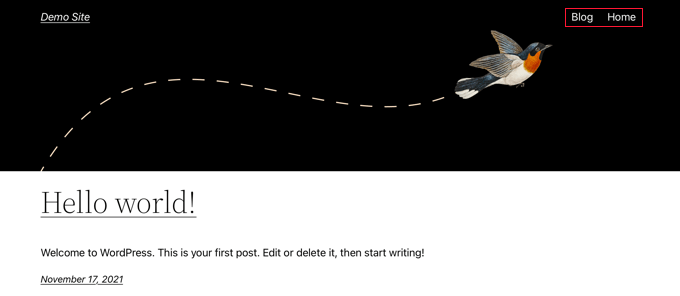
Personalizzazione della pagina iniziale
Finora la vostra nuova home page è vuota. Ora è il momento di aggiungere informazioni sulla vostra attività, sui prodotti e sui servizi e di far sapere ai visitatori come possono contattarvi.
Potete imparare a farlo nella nostra guida su come creare una home page personalizzata in WordPress. Nel Metodo 1, vi mostriamo come utilizzare l’editor di blocchi per aggiungere immagini di copertina, colonne, tabelle, testo e media, gallerie e altro ancora.
Troverete anche molte idee di personalizzazione creativa nella nostra guida su come modificare una home page di WordPress in modo semplice ed efficace.
Personalizzazione della pagina del blog
Se siete soddisfatti dell’aspetto della pagina del vostro blog, il vostro lavoro è finito.
Tuttavia, se attualmente si utilizza un tema a blocchi, è possibile personalizzare la pagina del blog visitando la schermata Aspetto ” Editor dalla dashboard di WordPress.
Una volta arrivati, selezionare l’opzione “Pagine” dalla colonna di sinistra nell’editor completo del sito.
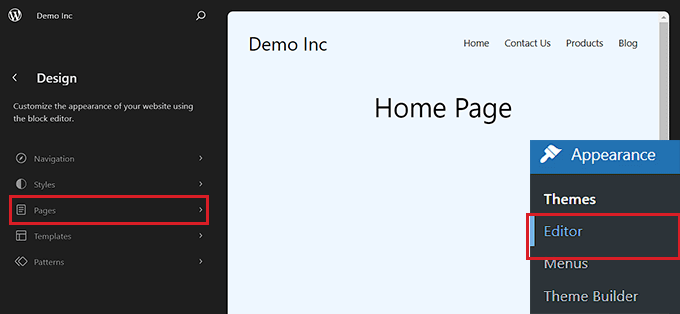
Si aprirà un elenco di tutte le pagine del vostro sito web nella colonna di sinistra.
Da qui, selezionare l’opzione della pagina ‘Blog’ e poi fare clic sull’anteprima della pagina a destra per iniziare a personalizzare la pagina del blog.
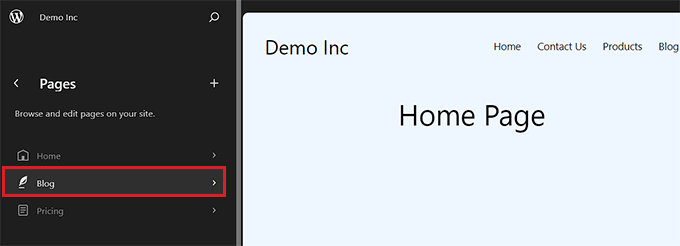
A questo punto è possibile fare clic sul pulsante “+” nell’angolo in alto a sinistra dello schermo e aggiungere alla pagina i blocchi desiderati.
Inoltre, è possibile modificare il colore dello sfondo, del testo o dei link della pagina del blog facendo clic sull’icona “Stili” nell’angolo in alto a destra dello schermo.
Si aprirà un pannello di blocco sulla destra da cui si può fare clic sulla scheda “Tipografia” per cambiare il colore del testo, sulla scheda “Colori” per cambiare il colore dello sfondo e sulla scheda “Layout” per configurare le dimensioni della pagina del blog.
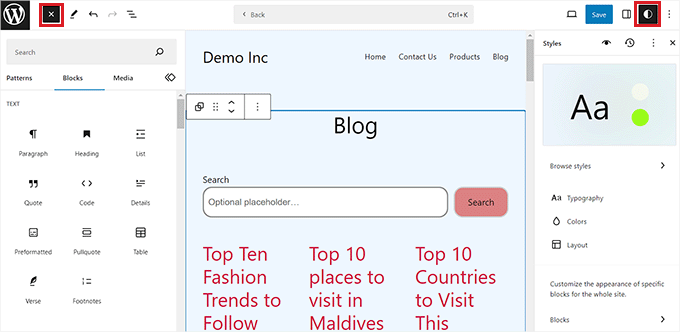
Una volta terminato, non dimenticate di fare clic sul pulsante “Salva” in alto per memorizzare le impostazioni.
Ora è possibile visitare la pagina del blog WordPress per vedere come appare.
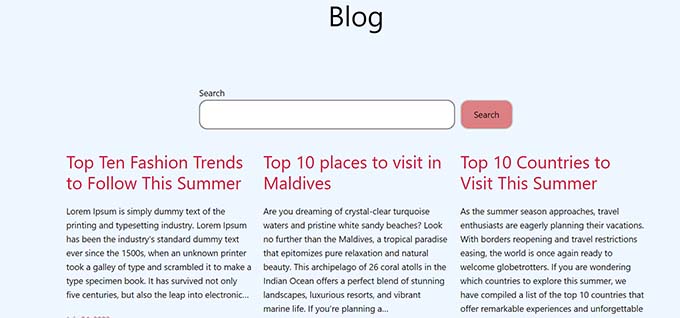
Tuttavia, se si utilizza un tema classico, è necessario utilizzare il metodo 2 per personalizzare la pagina dei post del blog.
Metodo 2: Creare una pagina personalizzata per i post del blog con un costruttore drag & drop (consigliato)
Un plugin per la creazione di temi consente di creare facilmente un tema WordPress personalizzato senza alcun codice. Questo include la possibilità di creare e personalizzare una pagina separata per i post del blog.
Installazione del costruttore di temi SeedProd
Per prima cosa, è necessario installare e attivare il plugin SeedProd. Per maggiori dettagli, consultate la nostra guida passo passo su come installare un plugin di WordPress.
SeedProd è il miglior costruttore di pagine WordPress drag-and-drop per aziende, blogger e proprietari di siti web. Dispone anche di un designer di temi che consente di personalizzare facilmente la pagina del blog e molto altro ancora.
Per maggiori dettagli, potete leggere la nostra recensione completa di SeedProd.
Dopo l’attivazione, visitare la pagina SeedProd ” Impostazioni per inserire la chiave di licenza. Queste informazioni sono disponibili nel proprio account sul sito web di SeedProd.

Dopodiché, è il momento di creare un tema WordPress personalizzato. È molto più semplice di quanto sembri.
Creare un tema WordPress personalizzato
Per prima cosa, è necessario visitare la pagina SeedProd ” Theme Builder. Qui si utilizzerà uno dei temi già pronti di SeedProd come punto di partenza. In questo modo si sostituirà il tema WordPress esistente con un nuovo design personalizzato.
È possibile farlo facendo clic sul pulsante “Temi”.
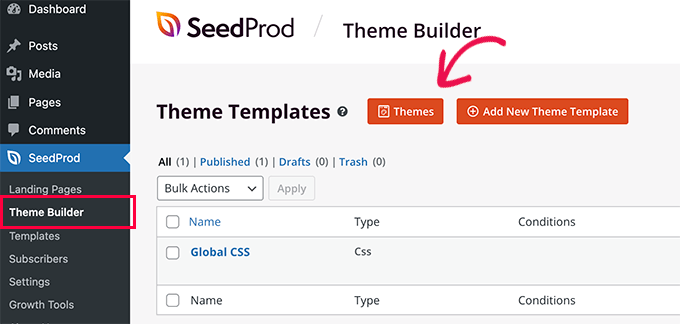
A questo punto vi verrà mostrato un elenco di temi professionali progettati per diversi tipi di siti web.
Ad esempio, esistono modelli chiamati “Modern Business”, “Marketing Agency” e “Mortgage Broker Theme”.
Date un’occhiata alle opzioni e selezionate quella più adatta alle vostre esigenze facendo clic sull’icona del segno di spunta.
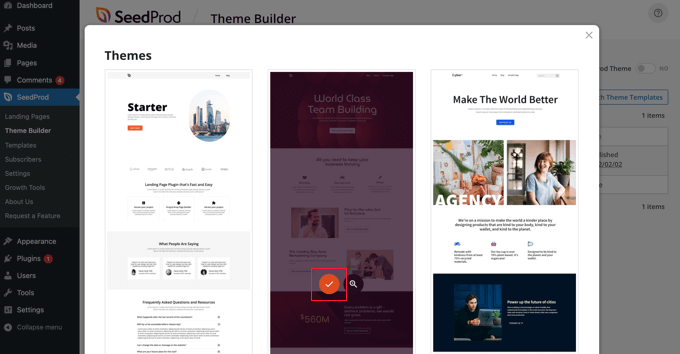
Una volta scelto il tema, SeedProd genererà tutti i modelli di tema, tra cui uno per l’indice del blog e uno per la pagina iniziale.
Non si tratta di pagine vuote, ma di layout accattivanti e di contenuti segnaposto facili da personalizzare.
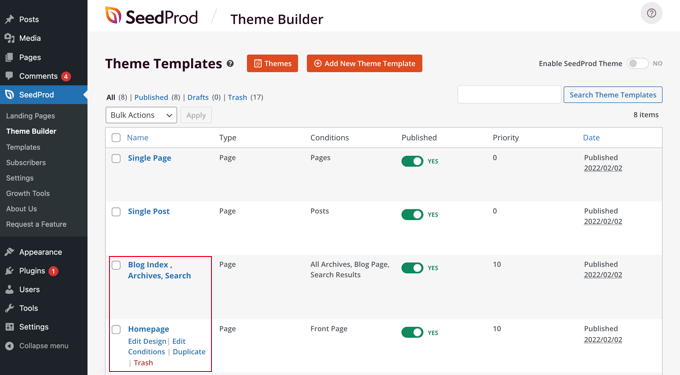
In questo tutorial vi mostreremo come personalizzare i modelli della home page e dell’indice del blog.
Potreste anche voler personalizzare gli altri modelli. Per sapere come fare, consultate la nostra guida per principianti su come creare facilmente un tema WordPress personalizzato.
Personalizzazione della pagina iniziale
Una volta generati i modelli del tema, è possibile modificarli utilizzando il costruttore di temi SeedProd. Inizieremo con il modello Homepage.
Per iniziare, è sufficiente fare clic sul link “Modifica design” sotto la homepage.

In questo modo si avvia il file del modello nel costruttore di temi SeedProd.
Questo semplice costruttore drag-and-drop mostra un’anteprima live della pagina a destra e una barra degli strumenti di blocco a sinistra.
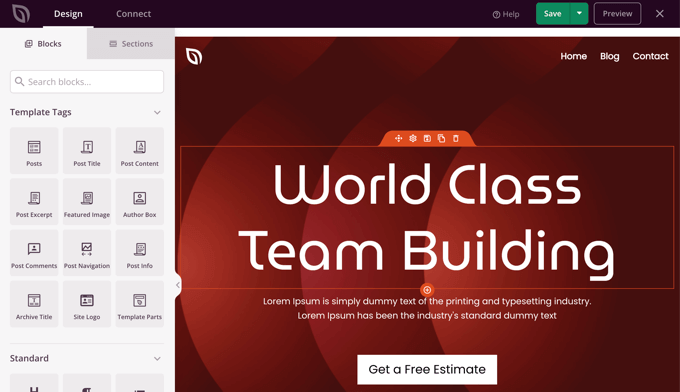
È possibile personalizzare qualsiasi blocco facendo clic su di esso, trascinando i blocchi in alto e in basso con il mouse e aggiungendo nuovi blocchi alla pagina.
Abbiamo scritto una guida completa su come creare una home page personalizzata in WordPress. Basta scorrere fino al Metodo 2 per imparare a personalizzare la vostra home page utilizzando SeedProd.
Personalizzazione della pagina del blog
Il costruttore del tema SeedProd offre anche molte possibilità di personalizzare la pagina di indice del blog.
Per iniziare, fate clic sul link “Modifica design” sotto la pagina.

Vedrete lo stesso riquadro di anteprima sulla destra e la barra degli strumenti sulla sinistra. È possibile personalizzare la pagina del blog nello stesso modo in cui si è fatto con la pagina iniziale.
Ad esempio, facendo clic sul titolo, è possibile visualizzare tutte le sue impostazioni. È possibile modificare il testo, cambiare l’allineamento e la dimensione dei caratteri e altro ancora.
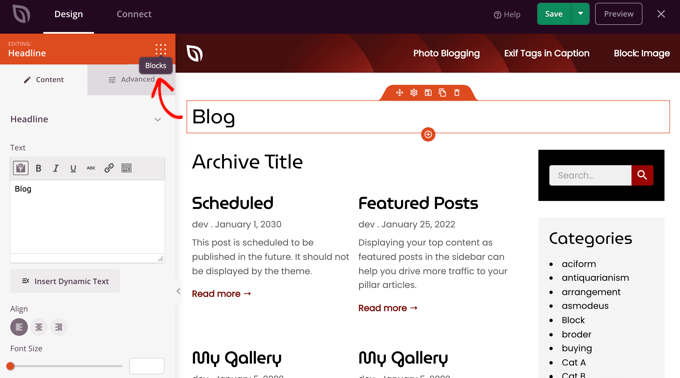
Una volta terminato, è necessario fare clic sull’icona ‘Blocchi’ per tornare alla barra degli strumenti.
Il costruttore del tema SeedProd offre ulteriori blocchi Template Parts, come il blocco Posts, che visualizza un elenco dei post del blog.
Il blocco Messaggi è già stato aggiunto al modello dell’indice del blog; in questo modello, il blocco visualizza i messaggi in due colonne. Possiamo cambiarlo in una singola colonna.
È sufficiente fare clic sul blocco Messaggi e modificare l’impostazione ‘Colonne’ in 1.
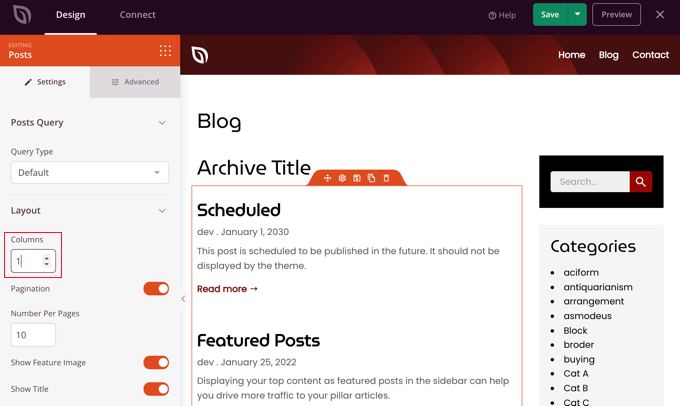
Il layout cambierà immediatamente in una singola colonna.
Scorrendo le impostazioni del blocco Messaggi, si trovano dei selettori che consentono di scegliere se visualizzare o meno l’immagine caratteristica e il titolo del post. Si può anche scegliere quale tag di intestazione utilizzare per il titolo del post.
Sono disponibili anche opzioni per la visualizzazione di diversi metadati dei post. È possibile modificare la data di modifica, l’autore, la data e l’ora di pubblicazione e il numero di commenti.
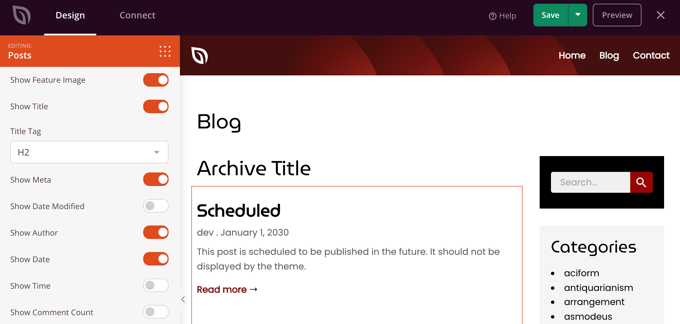
Ecco altri modi per personalizzare l’indice del blog:
- È possibile filtrare l’indice per tipo di post, categoria, tag o autore.
- L’ordine dei messaggi può essere modificato.
- È possibile scegliere quanti post visualizzare in una pagina.
- È possibile attivare l’estratto del post e personalizzarne la lunghezza.
Una volta terminata la personalizzazione della pagina del blog, assicurarsi di fare clic sul pulsante “Salva” nella parte superiore della schermata. Quindi, è possibile tornare all’elenco dei modelli facendo clic sull’icona “X”.
Abilitazione del tema SeedProd
Una volta terminata la personalizzazione dei modelli di tema, è necessario pubblicare il nuovo tema personalizzato.
È sufficiente spostare l’impostazione “Abilita tema SeedProd” su “SÌ”.
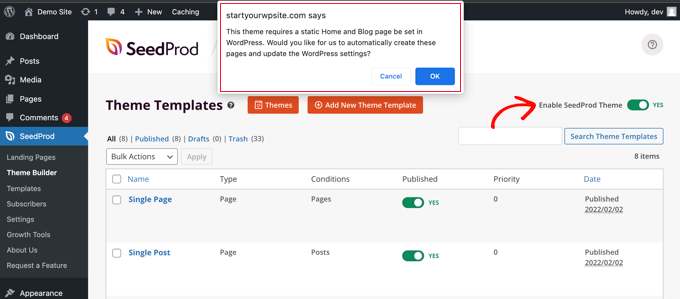
Verrà immediatamente visualizzata una notifica che indica la necessità di modificare le impostazioni delle pagine Home e Blog di WordPress. Facendo clic sul pulsante “OK”, queste impostazioni verranno modificate.
Ora è possibile visitare il sito web per visualizzare la nuova home page e la pagina del blog. Ecco come appare la pagina indice del blog sul nostro sito demo.
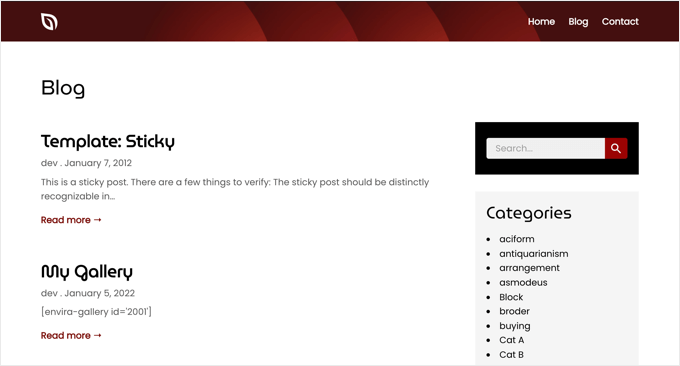
Bonus: visualizzare i post recenti in WordPress
Una volta creata una pagina blog separata, potete comunque mostrare alcuni post recenti nella vostra home page per incoraggiare gli utenti a esplorare meglio il vostro sito.
Per farlo, aprire la propria homepage nell’editor di blocchi di WordPress. Una volta lì, fate clic sul pulsante “Aggiungi blocco” nell’angolo in alto a sinistra dello schermo per aprire il menu dei blocchi.
Da qui, è sufficiente aggiungere il blocco “Ultimi messaggi” alla pagina. Una volta fatto ciò, è possibile personalizzare l’elenco dei post recenti per visualizzare gli estratti dei post, i nomi degli autori e le date secondo le proprie preferenze.
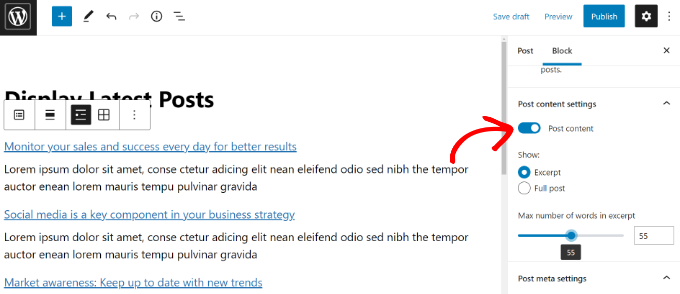
Infine, fare clic sul pulsante “Pubblica” in alto per salvare le impostazioni. Ora, alcuni dei vostri post recenti saranno ancora visualizzati nella home page per garantire che gli utenti trascorrano più tempo sul vostro sito web.
Per maggiori informazioni, potete consultare il nostro tutorial su come visualizzare i post recenti in WordPress.
Speriamo che questo tutorial vi abbia aiutato a imparare come creare una pagina separata per i post del blog in WordPress. Potreste anche voler imparare come aggiungere uno stato personalizzato per i post del blog in WordPress o consultare il nostro elenco dei migliori plugin per i post correlati per WordPress.
Se questo articolo vi è piaciuto, iscrivetevi al nostro canale YouTube per le esercitazioni video su WordPress. Potete trovarci anche su Twitter e Facebook.





Samson
I created a blog using the static homepage setting. But I have an issue. All the details of my blogs are opened in my blog section. My goal is to make it write a little tent about each blog section and skip to the next blog topic so that when clicked on, it would open fully the selected blog
Njofie Wilso
Great video. Really helpful.
I love WPbeginner.
WPbeginner has been a great resource to me.
Chantelle
Thank you so much! Have been struggling like forever to figure this out!!
Patrick
I’m trying to add posts to my blog post page, I went to the reading setting on the dashboard to enable the page I want as my blog page. Then I made a post and posted it to that blog page. It showed up on the right page, however it appears underneath the top header of the page, so the header is overlapping the post. Help!
Sarah
Thank you this was so easy! I’ve been trying to figure this out for ages now and I stumbled across your video.
Wanda
Hello:
Thank you so much. This was very helpful. I’m wondering if there is an easy way to create a header for the Blog page as my picture gets lost when you create a static home page. From what I gather, it can only be coded in HTML so I’m hoping there is more current good news on this.
WPBeginner Support
Hi Wanda,
You can try this, edit the blog page and set the image you want to use in the header as featured image. Most themes use the featured image as header in their page templates.
Admin
Tina Venema
what can i do so my home page feature image does not override the feature image I have chosen for my blog post page called ‘stories’. I have made my homepage static. thanks.
WPBeginner Support
Hi Tina,
It depends on your theme. Normally, if you set a featured image for your homepage then it should only appear on the homepage. However, some users confuse the featured image with the site-wide header image. Please contact your theme’s author for support, they would be able to help you out.
Alison
My posts are showing up as a thumbnail image. I just want it to look like a regular blog. What am I doing wrong?
Paige
This was perfect. Informative and easy to follow. Thanks so much!
Randy
Hi…I have followed the instructions but STILL don’t see my posts on my blog…also, my text in my welcome and about pages is at the bottom of the page…any ideas how to fix both of these…thx so much for your help…
Ellen Thornthwaite
Why doesn’t my WordPress look like this in the video? I have no ‘Reading’ under ‘Settings’. I have created a page called News and I have written a separate blog post but I cannot understand how to link the two.
Binay
Exactly! I am facing a similar problem.
Wood Hughes
Is it possible to have multiple posts pages in WordPress?
My concept is one page for gardening posts, one for real estate advice, and one for commerical land training information.
WPBeginner Support
Hello,
Please see our guide on how to add topics in WordPress navigation.
Admin
Mathukutty P. V.
Just found this tweet and tried. Never knew about creating a page for blog posts. Thanks a lot.
Mary
The information of easy to follow and helped me do what I’ve been trying to accomplish for awhile. Thx
Max Shea
Complicate the simple. Make the simple complicated. That’s WordPress.
tricia norris
Your explanation makes sense, but where does the existing home page go? I am creating a new home page, but does that mean I need to build a new home page?
Micki Allen
Thank YOU!
Anirban Karmakar
Is there any SEO benefits to Create a Separate Page for Blog Posts in WordPress? Or any SEO losses when I change my default Blog Post location to a custom page?
Sally
Hello! This is great…but! Can you help me add a SECOND blog page to my website?
WPBeginner Support
Hi Sally,
If you want to add numbers below blog page, then please see our guide on how to add numeric pagination in WordPress.
Admin
Danielle
How to add a blog page to page builder for mobile menu in wordpress? It seems like The blog page isn’t visible there.
Joan
this article was great. I think I need to start over! cause when I click on blog, the blog I wrote is over all the pictures from the front page and from the one I attached to a particular blog. This is way too hard.
Olivia
Hey, could you please help me? I really want to be able to sort my posts into different pages on my blog to keep things organized. Is this possible? If not, is there any alternative that could help me to post images with captions sort of like “posts” instead of just making the page look like that permanently? I want to be able to view a sort of gallery of images, and when I click on them get the full-screen version with captions. I found a perfect theme to let me do this, but I can’t get these to go anywhere but the front page! I really want to copy these posts onto my different pages.
Kim
THANK YOU. This was driving me nuts and your explanation couldn’t have been easier for this non techie website builder
Mort Wakeland
The info and video seem a bit dated for my WordPress does not have some of the options discussed. The video is pretty good except in places she skips steps. We are beginners, not experts, and we need all the “bread crumbs” we can get.
I followed the directions as best as I could, knowing this latest version of Word Press does not have a lot of the steps mentioned, e.g., there are no “discussions” to uncheck.
When I access my website, there was a static page with only Home listed. Where is Blog?
Reading additional sites, it appears the theme one installs has something to do with what shows and does show on the home screen – correct? To me this is a convoluted mess with no straightforward instructions. Most frustrating. If the theme is important, as some websites suggest, then why is it not one of the first things mention?
For me – I’ve already generated a blog and it works. I need to also generate a webpage for the communications class I’m in. So, with a blog already present, how does one add a static home page, wherein one can access the blog that has already been made in WordPress. Seems straightforward – but it’s not for I cannot find a fix to this question. Any advice, suggestions on sites to read, would be appreciated. This is like making a “mountain out of a molehill.”
Best evening wishes,
Dave
I followed written directions using WordPress 4.9.1 and found the discussions checkbox; try ignoring the video.
To have the Blog page be selectable as the Posts page, you have to create the Blog page first.
Themes may mangle a lot of WordPress instructions, there’s no way an instructional blog can know that, and it might be discouraging to state that at the beginning; this kind of thing is generally normal in many things you can customize.
You can add a static home page in Setttings > Reading as stated in the instructions.
Ern Miller
I created a page called “Blog” and linked to it, but I cannot figure out how to add blog posts to it, except to edit the “Blog” page as a static document. I cannot figure out how to link to blog entries.
IShita
My admin side bar doesn’t show me the reading tab everyone is referring to. I am using WordPress.com and want to post different blog posts to different pages. Just blog posts. Nothing else. Help Please. I have zero background in CSS or anything as such.
Thanks.
WPBeginner Support
Hi IShita,
This article is about self hosted WordPress.org websites. Please see our guide on the difference between self hosted WordPress.org vs free WordPress.com blog.
Admin
Sam Jane Price
Thanks so much for this info. Quick & easy fix
Danielle
I set up my site similar to the video except that I have my posts as News, and they are pushed to the News page. However, once a user navigates away from the homepage to the News page, the menu breaks and they cannot get back home, unless by clicking the back button. I know this has something to do with my file hierarchy (as I installed wordpress to my server manually) but I can’t identify where to fix this. Anyone have an idea what I’m doing wrong? Much appreciated!
Vidya Venugopal
Problem solved, Thanks!
Anjali Kulkarni
Still it not clear to me I have my own site at and it has some pages too but I want more pages for different section just like this site has “start here” deal and so on if create pages then how to add that blog to specific page, please explain in details….
gabriel
This solved my problems, thanks
Soren Pejstrup
Thanks for all you great content. I’m shifting fra Joomla to WordPress, and I’m enjoying it – and you’re helping me on the way. Thanks so much.
I’ve build out a couple og blog pages on different sites new.
In Joomla I was used to sort pages with post by popularity so that the most visited (not the newest) where on top.
Do you know how this can be done in WordPress?
Thx Soren
Sara
This was just what I was looking for. I usually use WordPress templates that already have the blog page specified, but now I won’t need to do that. Thanks to your instructions, I can easily do it myself!
Laura
I have all of this set up, but now my header image will not show up on my posts page. It shows up on the backend (I use visual composer). But when I preview my blog page, it takes me to the homepage and when I actually go to my live blog page, the posts are there but not the header image.
Does it have something to do with my theme?
Thank you!
Odinn Burkni
I have the exact same problem. There’s no header image on the blog page even though I have it set up on the page in wp-admin.
Jenn
Thank you! This video was great, exactly what I was looking for!
Musa Hussen
I have static page for home page and blog page for all of default post..Now I want to display some post on my home page. How could I do it. Thanks
WPBeginner Support
Hi Musa,
There are multiple ways to do that. You can use the Display Posts Shortcode plugin. You can also use the Recent Posts Extended Widget plugin.
Admin
peter
hi WP beginners, how can i post multiple posts in a page. i have like sports, tech… but i can only post in the home page. please reply, thanks.
Sian
I don’t most of those settings as my WordPress looks nothing like that. Why is that, what can I do?
WPBeginner Support
Hi Sian,
You are probably using WordPress.com. Please see our guide on the difference between self hosted WordPress.org vs free WordPress.com blog.
Admin
leanne ferguson
I have created separate pages for different subject areas and now want to add multiple posts to each subject area that will have different themes I.e. one of my pages is called museum trips and exhibition’s and on that page I want to add separate blogs or posts about different museums I have visited which will include photographs. how do I do this please?
Rich
Did you ever get an answer?? i am trying to do the same thing…google picks up your comment and brings me to this post.
Steven Denger
Hello Leanne – I have just recently started to use “posts” instead of pages, except for 1 or 2 exceptions. You go into the Posts > Categories and create a parent category: Museum Trips. Then you can create another category and title it “Museums Visitied” (or somenthing of that nature) and make it a parent (by not checking any parent categories).Then when you make a post about Museum trips, check that category box “Museum Trips” in your post editor on the right near the page attributes. As well, when you make “Museums Visited” posts, you can check that box to indicate which category it goes under, which would be Museums Visited. Now go to your “Menus” and create menu items under the “category” panel just under the normal place of menus. You just check the boxes and then click”Add Menu Items” and then they will be linked just as any other menu link on your nav bar. When the menu links are clicked, you will see just the posts features under that particular category. It is a great way to “segment” your contents and organize them.
As you create posts about one subject or the other, just make sure you check which category it goes in and it will show up there in it’s separate feature page, just like you want.
You may have already figured this out, but I just now saw your post so I thought I would answer. Good Luck.
kelsey
HELP!!!!!!!! THIS BROKE MY HOME PAGE!!!!!!!! I’ve now lost my actual home page where is it??? How do I undo this????????
WPBeginner Support
Hey Kesley,
Start the tutorial again and undo the steps you took earlier.
Admin
akhlaq
hello, nice tips.
i would to ask you how to make my url is like this
mydomain.com/tutorial-web/post.html and not mydomain.com/category/tutorial-web/post.html
and if my visitor go to mydomain.com/tutorial-web/ the will find all post with ‘Tutorial Web’ category at that page
sorry for my bad english
Thanks for your tutorial, your website is amazing for beginner like me
Lauren
Hi
This is a very useful post – except when I go on settings there literally isn’t a reading settings section. Can you help me?? I might just be being stupid but I need assistance asap
Thank you
Tirso
Hi, thanks for your information, but I have a problem with the menu on my posts page in my wordpress.
Here is the thing… I created a new page for posts as you said and I set a menu I created for posts and pages (as secondary menu) and everything is fine with the menu until I switch that page to “Posts page” on “Settings > Reading”… When I do that, it changes the menu to my “primary menu” automatically and I don’t know what to do so that it takes the secondary menu…
Hope you can help me!
Donald
I’d actually already done what you said in this video, but isn’t working as I was expecting. It does put the blog to ./blog as expected, however you can still see the blog (and about and contact etc…) on the home page if you scroll down, and I was expecting to ONLY have the Home page visible. i.e. scroll down and only see the bottom of the home page. This is with the Twelve Seventeen theme (not sure if it’s related to that?). Is there a way to make ONLY the Home page display? (from the wording of the settings you’d think that’s what you’re doing, but that’s not what I see when done – see all the same stuff as before, but now the blog has a place of it’s own in addition)
Brittinni
How would you differentiate a home page verses an about page? I’ve read that both have a good bit of overlap.
Krishna Roy
hello WP beginners,
First of all I want to thanks for all wp tutorials. By watching your tutorials i have created a website + Blog . Its working fine. But i want to ask one thing. I have installed “bbpress” plugin for create forum in my website and when new users want to register in my blog then ” bbpress” not sending their passwords to their emails.
Can yo help me for that? how can i configure bbpress properly for new users registration.
WPBeginner Support
Hi Krishna,
Please see our guide on how to fix WordPress not sending email issue.
Admin
Joyce
OMG. Thank you so much. With all the you tube tutorials, there is nothing that I could find that actually detailed this specific required info. I am so glad I found this site. :o)
WPBeginner Support
Hey Joyce,
We are glad that you found this article helpful. You may also want to subscribe to our YouTube Channel for WordPress video tutorials.
Admin
Amanda
Hi,
Thank you, but what about if there is no Template option to choose in Page Attributes? I’m working with Twenty Seventeen and it is not an option.
Mark
Hi,
I have a static front page and a post page.
How do you put a title onto the Blog page?
It’s just it doesn’t flow with the look of the other pages! my site is so you can see what I mean.
Thanks
Mark
Jordan Stocker
This was a life saver – thank you!!
Nancy
Thank you for your help! I was very frustrated until you helped me.
Elakkiya
This page is very helpful to me!!!. Thank you…